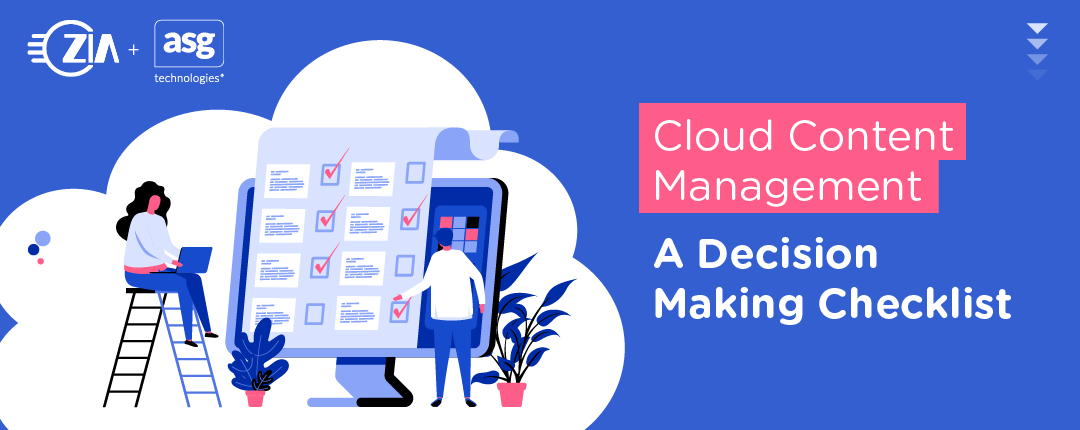At this year’s AIIM conference, Greg Wilson, director of content services for ASG Technologies, and I, Ryan McVeigh, managing partner of Zia Consulting, hosted a roundtable discussion. We provided company leaders with a checklist of considerations around cloud content management. We also refer to cloud content management as content services.

Ryan McVeigh
Managing Partner
Zia Consulting

Greg Wilson
Director, Content Services
ASG Technologies
When building a content management strategy, it’s difficult to support the needs of users, customers, and back-office processes when leveraging on-premises ECM systems. Recent AIIM research shows that only 22% of knowledge workers have mobile access to critical content. Maybe that’s why 65% of users with legacy ECM systems report issues with unsanctioned file sharing tools. There’s an alternative approach that supports the needs of the digital workplace and the business. This brings all of your people, information, and applications together to transform how you work. Cloud content management, or a mix of on-premises and cloud with hybrid-cloud deployments, makes this possible.
We learned by polling our attendees that they were interested in many aspects of cloud. The following seven discussion points were agreed to be the most critical and important. We created the following checklist to address utilizing the cloud as a part of an enterprise content infrastructure.
1. Firstly, where are you on the spectrum of cloud and managed services?
Assess in an honest way your interest and expertise in these services.
Do you have the technical ability, time, budget, and the knowledge to own the project solution? What will this look like after implementation?
Once this is determined, we can have a constructive conversation about what you need. Managed services are different for every entity. This can include upfront consulting, managed, migration, day to day administration, regular upgrades, and more. A unique solution is necessary for any entity embarking on this journey.
2. In considering cost, are you comparing apples to apples?
Managing content in the cloud versus on-premise have different costs. For example, the purchase of on-premise hardware does not compare to leasing hardware in a cloud data facility. This is because leasing might include the costs to cover insurance, fire suppression systems, on-site security, heating and cooling, and so on. Be aware of these factors in your cost justification.
Does your industry experience seasonal spikes in activity, such as the holiday season for retail, or tax season for financial services?
If so, the ability to auto-scale can significantly impact the cost of rolling up resources when needed, as opposed to managing infrastructure that is dormant most of the time.
3. What is your level of expertise?
Do you have the know-how to perform the migration, turn on servers, and take advantage of the native services that your preferred cloud provider offers?
Does your organization have the commitment, funding, and skill sets required for the day-to-day management of cloud solutions?
Take an accurate assessment of the expertise—and culture to take on new challenges—in your organization. Then, you’ll know how much time and the ability of the consultants you may require.
4. Have you revisited your corporation’s information security policies?
What needs to be asked and answered as you’re taking on cloud services?
Note that the questions you’re asking about cloud security are no different than you’d be asking for on-premise deployment. They’ve been asked before. Some of the world’s largest financial businesses and government entities run their business in the cloud. Features like encryption at rest, redaction, and event-based retention become even more important in a cloud environment.
Despite having moved your Human Resources and Accounts Payable systems to the cloud, there are still documents and personal information that need to be protected. It can be crucial to have a Content Management platform sitting behind these front-end systems to ensure you are secure in the Cloud.
5. Are you differentiating between cloud native and SaaS?
Depending on your current solution, it’s important to understand the difference between SaaS (software as a service) applications and cloud native applications. Many people equate SaaS with the cloud, but they have differences.
SaaS applications are wholly offered and managed by a software vendor. It’s typically licensed by the user or volume, not by the instance. Software vendors who offer cloud-native solutions, such as Mobius from ASG Technologies, have architected their products to take advantage of cloud-native services. They are able to be deployed most efficiently in the cloud.Buyers should look for software solutions that have been architected to utilize cloud native functionality when considering cloud content management. This may include business continuity, auto-scaling, and cloud-vendor specific services.
6. Will you need a hybrid model during migration?
You’ll need to carefully contemplate how to successfully pull off a migration. It doesn’t happen overnight. It’s typically done in stages. So, it accounts for applications that communicate with core services and are being connected to the new cloud infrastructure. To best suit your needs, many times it makes sense to implement a hybrid infrastructure for a period of time, or as an end state.
Mobius is unique in that our on-premises and cloud instances can communicate with each other and share files and security policies, helping your organization to bridge the gap between your Cloud applications and legacy on-premises systems.
Ultimately, every customer has a different need and would require analysis. We’ll figure it out with you.
7. Don’t forget about your bandwidth.
By bandwidth, we mean two distinct things: literally, the internet speed in the cloud, and the number of hours you have available to work on the solution. Plan accordingly, depending on your usage patterns, to invest and test for appropriate response times. Cloud user experience should be akin to the on-premise response times.
This isn’t an exhaustive list, but this is what we discussed in our roundtable discussion, acknowledging that all customers are unique and will require individually tailored solutions. From managing content chaos to encouraging digital engagement and satisfying security and compliance requirements, we’re happy to continue the conversation with you.
Zia partners with ASG Technologies and other software vendors that are well-suited to help you modernize your business and leverage the cloud. We offer a myriad of services, including strategic consulting, managed services, and cloud migrations. Give us a call today.

